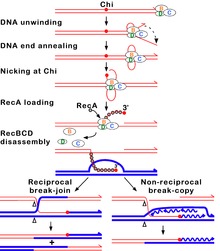RecBCD
Exodeoxyribonuclease V (EC 3.1.11.5, RecBCD, Exonuclease V, Escherichia coli exonuclease V, E. coli exonuclease V, gene recBC endoenzyme, RecBC deoxyribonuclease, gene recBC DNase, gene recBCD enzymes) is an enzyme of E. coli that initiates recombinational repair from potentially lethal double strand breaks in DNA which may result from ionizing radiation, replication errors, endonucleases, oxidative damage, and a host of other factors.
[5] Finally, RecBCD enzyme (perhaps the RecC subunit) recognizes a specific sequence in DNA, 5'-GCTGGTGG-3', known as Chi (sometimes designated with the Greek letter χ).
[9] The ss tails can anneal to produce a second ss loop complementary to the first one; such twin-loop structures were initially referred to as “rabbit ears.” During unwinding the nuclease in RecB can act in different ways depending on the reaction conditions, notably the ratio of the concentrations of Mg2+ ions and ATP.
This tail can be bound by RecA protein, which promotes strand exchange with an intact homologous DNA duplex.
[14] When RecBCD encounters a Chi site on the 3' ended strand, unwinding pauses and digestion of the 3' tail is reduced.
The joint DNA molecule is thought to be resolved either by replication primed by the invading 3’ ended strand containing Chi or by cleavage of the D-loop and formation of a Holliday junction.
[22] In the bacterium Escherichia coli, RecD protein is part of the well studied RecBCD complex that is necessary for recombinational DNA repair (as described above).
[21] RecBCD is a model enzyme for the use of single molecule fluorescence as an experimental technique used to better understand the function of protein-DNA interactions.

